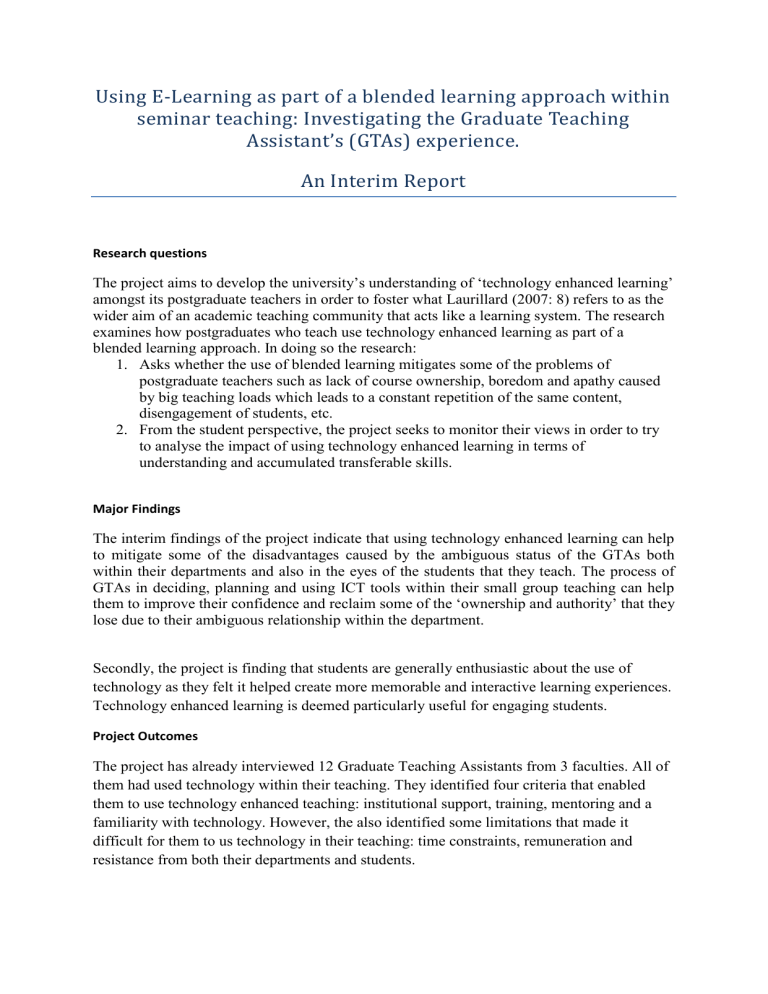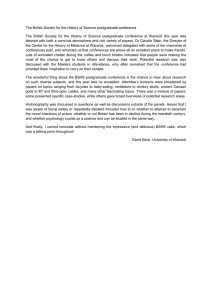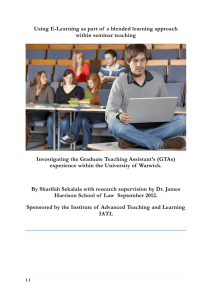Using E-Learning as part of a blended learning approach within

Using E-Learning as part of a blended learning approach within seminar teaching: Investigating the Graduate Teaching
Assistant’s (GTAs) experience.
An Interim Report
Research questions
The project aims to develop the university’s understanding of ‘technology enhanced learning’ amongst its postgraduate teachers in order to foster what Laurillard (2007: 8) refers to as the wider aim of an academic teaching community that acts like a learning system. The research examines how postgraduates who teach use technology enhanced learning as part of a blended learning approach. In doing so the research:
1.
Asks whether the use of blended learning mitigates some of the problems of postgraduate teachers such as lack of course ownership, boredom and apathy caused by big teaching loads which leads to a constant repetition of the same content, disengagement of students, etc.
2.
From the student perspective, the project seeks to monitor their views in order to try to analyse the impact of using technology enhanced learning in terms of understanding and accumulated transferable skills.
Major Findings
The interim findings of the project indicate that using technology enhanced learning can help to mitigate some of the disadvantages caused by the ambiguous status of the GTAs both within their departments and also in the eyes of the students that they teach. The process of
GTAs in deciding, planning and using ICT tools within their small group teaching can help them to improve their confidence and reclaim some of the ‘ownership and authority’ that they lose due to their ambiguous relationship within the department.
Secondly, the project is finding that students are generally enthusiastic about the use of technology as they felt it helped create more memorable and interactive learning experiences.
Technology enhanced learning is deemed particularly useful for engaging students.
Project Outcomes
The project has already interviewed 12 Graduate Teaching Assistants from 3 faculties. All of them had used technology within their teaching. They identified four criteria that enabled them to use technology enhanced teaching: institutional support, training, mentoring and a familiarity with technology. However, the also identified some limitations that made it difficult for them to us technology in their teaching: time constraints, remuneration and resistance from both their departments and students.
Throughout the project, the students are being asked for periodic feedback which was generally positive.
A final has been distributed to 60 students at the end of the academic year dealing specifically with their experiences with technology. Of these 58 questionnaires were usable. 19 of these were male students and 37 were female. All but one was within the 18-25 age group. The questionnaires give us useful data on student experiences of using technology. The majority of them found it useful and gave us various in-depth comments about its use within their seminars and suggestions for future use.
Furthermore, the questionnaires also provide a useful snapshot of students use of technology within university settings. 27 identified themselves as using technology for more than 10 hours a day, 21 students said they used technology for up to 10 hours a day and 6 said that they used technology for 5 or more hours a day. Such data can raise interesting questions about how students read and access information within universities today.
Furthermore, students report that the use of some of the less common technologies provided an egalitarian function. This is one of Warwick’s objectives in widening participation and this was achieved by enabling students from poorer educational backgrounds to take advantage of technology which students from more resourceful schools were accustomed to. i.e. smartboards, tablets, clickers etc.
We have already prepared two interim reports for the teaching Grid: one on postgraduate teachers and the other on student experiences in using the open learning space.
Dissemination of results
The interim findings of the project have been presented to the Annual Social Legal Studies
Conference in Leicester in April 2012. We have also presented our interim findings to the
Teaching and Learning Showcase in Warwick in September 2012.
We are currently working on a draft journal article that is going to be submitted to the Journal of Higher Education in October. We have received invaluable feedback from two professorial teaching fellows from the Law School and the Business School.
We will also disseminate the findings at the Law School Teaching Day in September and also at a workshop specifically targeted at teachers who are interested in using technology in higher education. We will launch an official report of the project at this time. The official report will be written up over the next two months.
Wider application in Warwick University
The use of technology has also been incorporated in some of the Bhopal case that Sharifah is writing for the Warwick Business School Case database as part of its on-going Case Method
Teaching Project.
Sharifah has also used technology enhanced learning in her lectures for WBS summer school.




